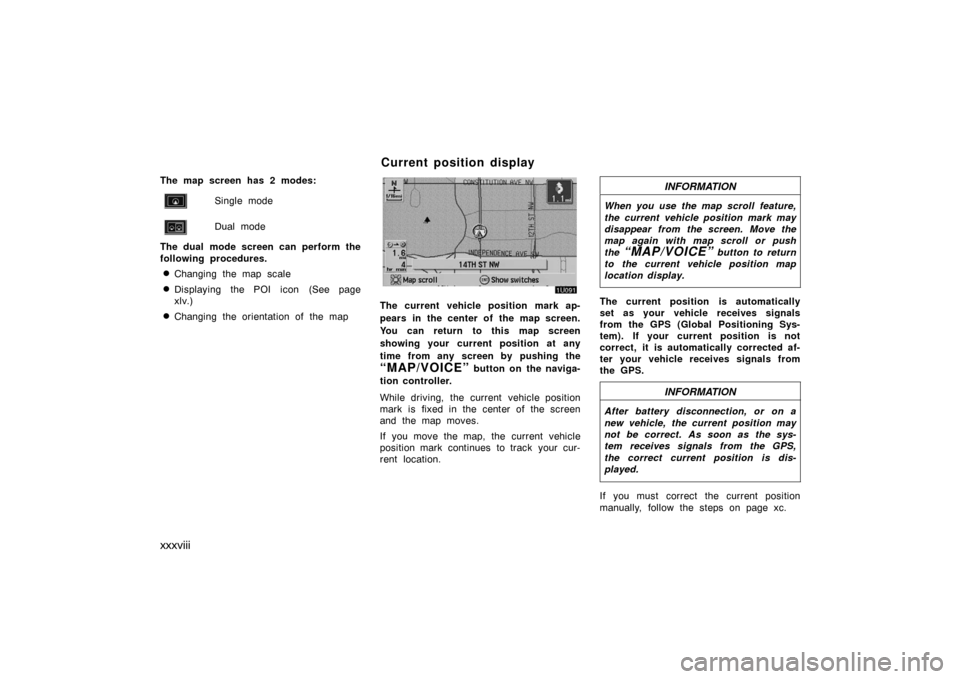Page 38 of 138

xxxviii
The map screen has 2 modes:
Single mode
Dual mode
The dual mode screen can perform the
following procedures.
�Changing the map scale
�Displaying the POI icon (See page
xlv.)
�Changing the orientation of the mapThe current vehicle position mark ap-
pears in the center of the map screen.
You can return to this map screen
showing your current position at any
time from any screen by pushing the
“MAP/VOICE” button on the naviga-
tion controller.
While driving, the current vehicle position
mark is fixed in the center of the screen
and the map moves.
If you move the map, the current vehicle
position mark continues to track your cur-
rent location.
INFORMATION
When you use the map scroll feature,
the current vehicle position mark may
disappear from the screen. Move the
map again with map scroll or push
the
“MAP/VOICE” button to return
to the current vehicle position map
location display.
The current position is automatically
set as your vehicle receives signals
from the GPS (Global Positioning Sys-
tem). If your current position is not
correct, it is automatically corrected af-
ter your vehicle receives signals from
the GPS.
INFORMATION
After battery disconnection, or on a
new vehicle, the current position may
not be correct. As soon as the sys-
tem receives signals from the GPS,
the correct current position is dis-
played.
If you must correct the current position
manually, follow the steps on page xc.
Current position display
Page 53 of 138

liii
When your vehicle is not receiving signals
from the satellites, the “GPS” mark does
not appear at the screen.
The GPS signal may be physically ob-
structed, leading to inaccurate vehicle
position on the map display. Tunnels, tall
buildings, trucks, or even the placement of
objects on the instrument panel may ob-
struct the GPS signals.
The GPS satellites may not send signals
due to repairs or improvements being
made to them.
Even when the navigation system is re-
ceiving good GPS signals, the vehicle
position may not be shown accurately or
inappropriate route guidance may occur in
some cases.
NOTICE
The installation of window tinting may
obstruct the GPS signals. Most win-
dow tinting contains some metallic
content that will interfere with GPS
signal reception. We advise against
the use of window tinting on vehicles
equipped with navigation systems.
�When driving on a small angled Y−
shaped road.
�When driving on a spiral road.
�When driving on a slippery road such
as in sand, gravel, snow, etc.
�When driving on a long straight road.
�When freeway and surface streets run
in parallel.
�After moving by ferry or vehicle carrier.
�When a long route is searched during
high speed driving.
�When driving without setting the current
position calibration correctly.
�After repeating a change of directions
by going forward and backward, or
turning on a turntable in the parking
lot.
�When leaving a covered parking lot or
parking garage.
�When a roof carrier is installed.
�When driving with the tire chains
installed.
�When the tires are worn.
�After replacing a tire or tires.
(a) Accurate current vehicle
position may not be shown in
the following cases:
Page 54 of 138

liv�
When using tires that are smaller or
larger than the factory specifications.
�When the tire pressure in any of the
four tires is not correct.
INFORMATION
If your vehicle cannot receive GPS
signals, you can correct the current
position manually. For the information
on setting the current position cal-
ibration, see page xc.
�When turning at a wrong intersection
off the designated route guidance.
�If you are heading for a destination
without passing through a set preferred
road, automatic rerouting may display
a route returning to the set preferred
road.
�When turning at an intersection for
which there is no route guidance.
�When passing through an intersection
for which there is no route guidance.
�During automatic rerouting, the route
guidance may not be available for the
next turn to the right or left.
�It may take a long time to operate
automatic rerouting during high speed
driving. In automatic rerouting, a detour
route may be shown.
�During automatic rerouting, the route
may not be changed.
�The route in a U−turn may be shown
or announced.
�A location may have multiple names
and the system will announce one or
more.
�Some routes may not be searched.
�If the route to your destination includes
gravel, unpaved roads or alleys, the
route guidance may not be shown.
�Your destination point might be shown
on the opposite side of the street.
�When a portion of the route has regu-
lations prohibiting the entry of the ve-
hicle that vary by time or season or
other reasons.
�The road and map data stored in your
navigation system may not be complete
or may not be the latest release.
After replacing the tire, implement the
operation described in the “Current
position calibration”. (For details, see
page xc.)
This navigation system uses tire turning
data and is designed to work with factory−
specified tires for your Toyota. Installing
tires that are larger or smaller than the
originally equipped diameter may cause
inaccurate display of the vehicle’s posi-
tion. The tire pressure also affects the
diameter of the tires so please make sure
the tire pressure of all four tires is cor-
rect.
(b) Inappropriate route
guidance may occur in the
following cases: